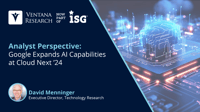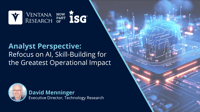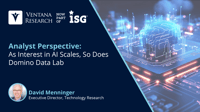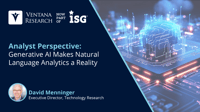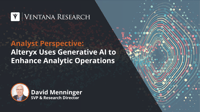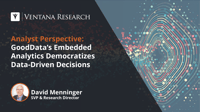The artificial intelligence (AI) market is exploding with activity, which is part of the reason we recently announced that we have dedicated an entire practice at Ventana Research to the topic. Large language models (LLMs) and generative AI (GenAI) have taken the AI world by storm. In fact, we assert that through 2026, one-half of all AI investments will be based on generative rather than predictive AI. My colleague Rob Kugel has written about how AI can improve productivity and benefit the...
Read More
Topics:
AI,
natural language processing,
AI & Machine Learning,
Analytics & Data,
Generative AI
In the technology industry, 2023 will be remembered as the year of generative artificial intelligence. Yes, the world was made aware of GenAI when ChatGPT was publicly launched in November of 2022, but few knew the impact it would have at that point in time. Since then, GenAI has taken the world by storm, with vendors applying the technology to make it easier to ask questions about data, write code (including SQL), prepare data for analyses, document data pipelines and use software products...
Read More
Topics:
AI,
AI & Machine Learning,
Analytics & Data,
Generative AI,
Model Building and Large Language Models
Unstructured data has been a significant factor in data lakes and analytics for some time. Twelve years ago, nearly a third of enterprises were working with large amounts of unstructured data. As I’ve pointed out previously, unstructured data is really a misnomer. The data is structured; it's just not structured into rows and columns that fit neatly into a relational table like much of the other information enterprises process. Consequently, it requires different skills, different technology...
Read More
Topics:
Artificial intelligence,
AI & Machine Learning,
Analytics & Data,
Computer Vision
We’ve been saying for years that natural language processing (NLP) and natural language analytics would greatly expand access to analytics. However, prior to the explosion of generative AI (GenAI), software providers had struggled to bring robust natural language capabilities to market. It required considerable manual effort. Many analytics providers had introduced natural language capabilities, but they didn’t really resonate with enterprise requirements. They required significant effort to...
Read More
Topics:
Business Intelligence,
Artificial intelligence,
natural language processing,
AI & Machine Learning,
Analytics & Data,
GenAI
Alteryx was founded in 1997 and initially focused on analyzing demographic and geographically organized data. In 2006, the company released its eponymous product that established its direction for what the product is today. In 2017, it went public in an IPO on the NYSE. At the time of the IPO, Alteryx was focusing much of its marketing efforts on the data preparation market, particularly to support Tableau. Throughout this time though, Alteryx offered much more than data preparation. As a...
Read More
Topics:
Analytics,
Business Intelligence,
data operations,
AI & Machine Learning,
Analytics & Data,
Analytic Operations
I am happy to share insights gleaned from our latest Buyers Guide, an assessment of how well vendors’ offerings meet buyers’ requirements. The Ventana Research 2023 Augmented Analytics Buyers Guide is the distillation of a year of market and product research by Ventana Research. Drawing on our Benchmark Research, we apply a structured methodology built on evaluation categories that reflect the real-world criteria incorporated in a request for proposal to Analytics and Data vendors supporting...
Read More
Topics:
Analytics,
AI & Machine Learning,
Augmented Analytics
The 2023 Ventana Research Buyers Guide for Augmented Analytics research enables me to provide observations about how the market has advanced.
Read More
Topics:
Analytics,
AI & Machine Learning,
Augmented Analytics
Organizations are continuously combining data from diverse and siloed sources for analytical, artificial intelligence and machine learning projects. As the volume of data grows, it becomes challenging for organizations to manage and keep current to extract valuable insights in a timely manner.
Read More
Topics:
Analytics,
Business Intelligence,
AI & Machine Learning,
Data Analytics
The current market landscape of data and analytics is undergoing rapid evolution, presenting organizations with a wide array of challenges and opportunities. As data sources and warehouses steadily migrate to the cloud, a significant number of organizations still depend on conventional tools. This reliance on legacy systems hinders the seamless accessibility and adoption of analytics and business intelligence within business processes. Organizations are increasingly turning to embedded...
Read More
Topics:
embedded analytics,
Analytics,
Business Intelligence,
Streaming Analytics,
AI & Machine Learning
